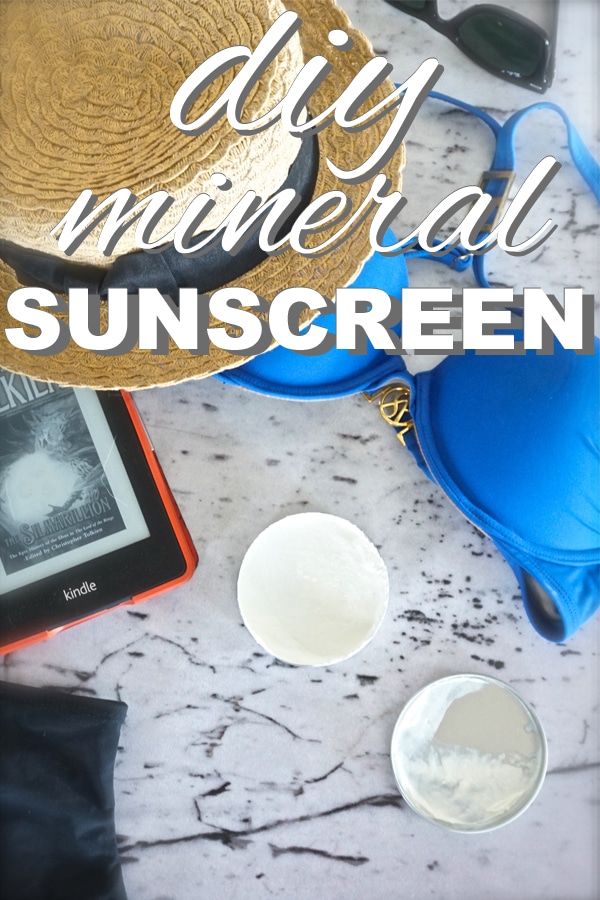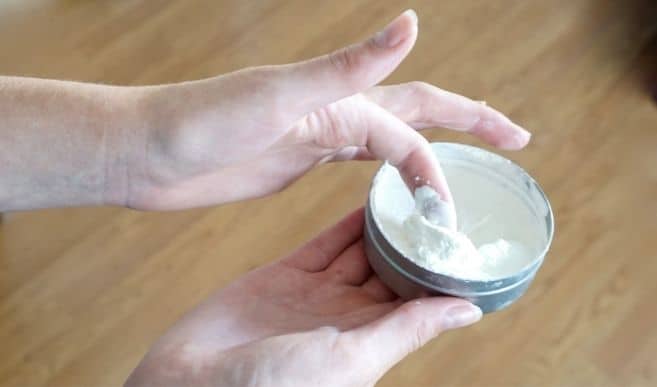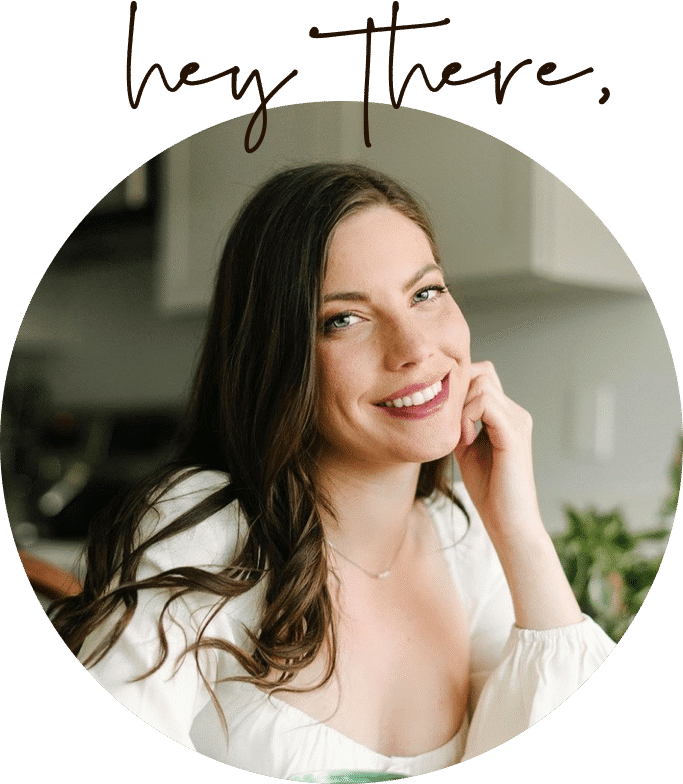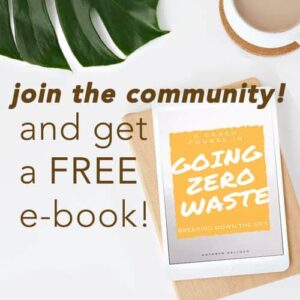Last Updated on June 3, 2022
NOTICE: When DIY sunscreen is mixed there’s no way to guarantee even coverage across your skin. That inconsistency can create major issues when it comes to protecting you from the sun. I do not recommend anyone make their own anymore. If you have a very specific allergy related circumstance please speak with your doctor or dermatologist. If you don’t have any allergy issues with off-the-shelf sunscreen and are just looking for products that are more eco-friendly or have more natural ingredients, check out my list of Eco-Friendly Sunscreen products.
All Natural Sunscreen will keep your skin safe from dangerous UVA and UVB sun rays and it’s easy to make.
Non toxic sunscreen leaves a thin layer on the skin to protect it from harmful rays. Unlike traditional sunscreens, mineral sunscreen ingredients are safe to use. Conventional sunscreen is absorbed by the skin and has been known to disrupt hormones, can damage skin and may even speed up skin cancer. Mineral sunscreen is not absorbed by the skin and is therefore considerably safer for you and your family.

I am a child of the sun. I was built for hot weather. I’m a lizard in need of a rock. I have desert heat coursing through my veins. I grab a sweater when it’s 74, and keep my office temperature at my preferred level of warmth – 82 degrees.
And, this cold blooded, sun-basker needs sunscreen. I grew up with this unnatural fear of being sunburned. Whether it stems from a natural fear or from my mother who consistently slathered me in white goop/freaked out at any sign of redness, is another question.
As much as I love sitting in the sun, I love not having skin cancer and premature wrinkles more.
Table of Contents
what is mineral sunscreen?
A mineral based sunscreen is a chemical free sunscreen that the skin doesn’t absorb, making it much safer than chemical sunscreen. This truly is the best mineral sunscreen and I am excited to be sharing it with you. It has a natural 30 SPF. Did you know 30 SPF provides 97% UVB protection? While 50 SPF provides only 2% more protection. Crazy right?
Mineral sunscreen is considered the safest by the EWG. It’s also considered “reef friendly.” Instead of absorbing into our skin, it sits on our skin. It’s a large enough particle that can’t penetrate. However, if inhaled or swallowed, it could be harmful. So, you should avoid putting it in make-up powders or in lip balm.
Check out a chapstick recipe that has a natural 15 SPF.
With traditional sunscreen you absorb it and it dissipates UVA and UVB rays. Mineral sunscreen reflects and scatters the rays. You can read more about it here.

what’s the big deal about vitamin D?
There’s a fine line between protection and over protection. We have been very diligent about our daily sunscreen application for years. You can find it in our lotions, make-up, and other skincare products. So, we’re actually seeing an onslaught of vitamin D deficiency.
Sunscreen is soooo good at protecting us from harmful UVA and UVB rays it also protects us from absorbing vitamin D. And, why is that important? I’m glad you asked.
You can only get vitamin D from the sun or a supplement. Our body makes vitamin D but only after the skin has been exposed to a sufficient amount of sunlight.
vitamin D is very important to us all
Vitamin D is a necessity in helping you absorb calcium. It also helps your immune system; because it’s intrinsically involved in the life cycle of human cells. In fact, vitamin D deficiency has been linked to a number of cancers, heart disease, and depression.
Don’t feel the need to apply the chemical free sunscreen every time you’ll be in the sun. You only need to apply it when you’ll be in direct sunlight for a prolonged time.
If I’m going to be in direct sun light more than 30 minutes, I apply my non toxic sunscreen. If I’m going to be out and about walking around town, I will leave it off. You can read more about vitamin D here and here.

why all natural sunscreen is better than conventional sunscreen
Now, that we’ve discussed the frequency of use, let’s talk about the bad stuff in conventional sunblock.
Like a lot of beauty products on the shelf, sunscreen isn’t really regulated. And, it is partially a lotion pumped with fillers. I looked up sunscreens I used to use on the handy dandy Skin Deep search bar provided by the EWG.
Skin Deep is this nifty app that tells you about all the bad stuff you’re putting on your skin, that you probably shouldn’t be. Prepared to be terrified as you search through every product you’ve ever used.
The neutrogena sheer sunscreen wasn’t so bad ranking a 5 out of 10, but the bullfrog was a 7! Personally, I like my products level 2 and below.
three ingredients you should avoid:
Oxybenzone: Helps the other chemicals penetrate the skin. It throws off our endocrine system. It completely disrupts our hormones. According to the CDC 97% of Americans have Oxybenzone in their system; because it accumulates faster than our bodies can get rid of it.
Retinyl Palmitate: It’s a form of vitamin A, but when it’s exposed to UV rays the retinol can break down. When it breaks down it releases free radicals that can damage the skin, DNA, and speed the development of skin cancer.
Paraben Preservatives: We’ve discussed Parabens before. I’m not the biggest fan. They’re endocrine disrupters. They mimic estrogen. And due to my previous health issues, I try to stay as far away as possible.
But, it doesn’t stop there!
Oxybenzone and warmer water temperatures are the leading cause of coral bleaching. 14,000 tons of sunscreen particles wind up in coral reefs a year. It basically leaches the coral of all its nutrients, which is greatly disrupting the fish and wildlife around the coral. You can read more about coral bleaching here.

Image from coolasuncare
30 SPF mineral sunscreen ingredients
- 1/4 Cup + 2 Tablespoons of Shea Butter: 3-6 SPF
- 1/4 Cup of Cocoa Butter: 0 SPF *
- 2 Tablespoons of Coconut Oil: 2-8 SPF **
- 2 Tablespoons of Olive Oil: 2-8 SPF **
- 2 Tablespoons of Vitamin E Oil: Natural Preservative helps prevent UV Damage
- 2 oz (approx 1/4 Cup) of Zinc Oxide: 20+ SPF
how to make the best mineral sunscreen
step 1: combine ingredients
In a double broiler melt the shea butter and cocoa butter or beeswax. After it’s melted, stir in the other oils. Let it cool for 2-3 minutes and then stir in the zinc oxide making sure not to inhale it.
step 2: let it rest
Let the mixture set up overnight and in the morning you’ll have a very nourishing sunscreen! It’s almost the texture of a body butter.

expert tips for making non toxic sunscreen
- You can use Carrot Seed or Raspberry Seed oils in place of olive and coconut. They have very high SPF around 30-40.
- Adding 2 tablespoons of beeswax will make the chemical free sunscreen a thicker and more solid texture.
how often should you apply chemical free sunscreen?
After an application of this all natural sunscreen, I can sit out in direct sunlight for 3.5 hours and not get burned. I would recommend applying every two – three hours though. The oxide is water resistant but not water proof. You’ll need to reapply after swimming.
Always be safe when in the sun for prolonged periods. Wear long, loose fitting clothing and hats. If you’ll be in prolonged sunshine where you can’t reapply, it’s better to buy a safer store bought sunscreen. Your health always comes first!
how do you store homemade all natural sunscreen?
Keep the all natural sunscreen in a glass jar with a lid. I prefer to keep it in the fridge, but you can keep it at room temperature as long as it’s not too hot. When it’s chilled it does feel really good when you apply it to your skin, so that’s an added bonus on those hot summer days.














Hi, I tried to make my own sunscreen by using a vegan body lotion and adding s replace amount of zinc oxide. It was brilliant to start with however after a month the mixture became very liquid and runny. Do you know why or how I can fix this?
I can’t really speak to that since I don’t know how that lotion was made. Sorry!
The ingredients come packaged in plastic so there is no savings there. What do you recommend?
I was able to get everything in bulk except the zinc oxide and the vitamin e. I’ll be reusing both of the bottles/containers. I can also make 5+ bottles of sunscreen wth the ingredients I have. If I weren’t going to use the containers they come in high numbers of plastic that have a good chance of being downcycled. But the squeeze bottles most sunscreens come in are a mixed plastic that can only be downcycled and are also made with ingredients I don’t particularly like. This was just the best option for me. 🙂
Hello,
Thank you for the post and your blog as you have many helpful tips for people starting out on a zero waste lifestyle. I do want to point out though that some people do need to wear sunblock, all the time, every day, all over, for health reasons. I have lupus and any exposure without sunblock is not a good thing. I think there may be other reasons some people may have to wear sunblock too. And yes, I have to supplement Vit D since i can’t get it from sun exposure. Keep the tips coming, your blog is very helpful and creative.
You are absolutely correct! Yes, I’m sorry if I failed to make that apparent. It is not safe for everyone. Thank you for bringing awareness to this.
I’m a beginner, your website is my new best friend! This is the one that scares me, I’m a redhead and catch a sunburn if I stand too close to a window. Send good vibes my way..
sending good vibes your way! Don’t hesitste to buy some reef safe sunscreen to try it out! I know they sell it in sustainable packaging. I have some from Aesop.
Hi there! Just starting my zero-waste journey and this recipe is incredibly helpful 🙂 Question though… I am a redhead and have to keep sunscreen with me at all times if I’m going to be out in the sun. On a particularly hot day, I’d be worried of this stuff melting in my bag!! Do they make double-walled containers that I could store my sunscreen in to hopefully reduce how much it melts? I don’t know what all is out there as far as containers go! Thank you <3
If you are outside for a normal amount of time, even when wearing sunscreen you will abosrb enough vitamin D. The idea that it is sunscreen causing vitamin D definciency tends to be a myth spread by those not wanting to wear sunscreen. It tends to be more that people aren’t going outside to begin with.
There are far more deaths from skin cancer. Also most processed foods have vitamin D added like cereal, milk and some orange juices.
Talk to any dermotologist and they will say that sunscreen is the most important products for your skin.
I love your blog – please keep writing posts! 🙂
Vitamin D deficency is most often caused by an inability to absorb it.
Is this reef friendly?
Hi, For someone who spends a lot of time in the water would you suggest adding more beeswax to create more of a thicker paste that will stay on. I’m planning to make a sunscreen especially for my face.
Hello, I would like to know how long this cream last please. Can i add some Preservative? Thanks x
Any ideas for making it tinted? I have an olive complexion and while adequate sun protection should come before vanity, I’m not a big fan of the ghostly white look ?
Do you have the measurements in metric? I can’t be sure how much 1/4 cups + 2 tbsp of butter weighs 🙁
A tablespoon= T or tbsp is 15 ml and is the same as the French "cuillère à soupe." A teaspoon is 5 ml or a "cuillère à café." A 1/4 cup is about 4 tbsp, so 60 ml.
Did you know that zinc oxide does not melt in oils or water, which is why if you just mix them together it will not create an even mix, hence no perfect coverage? You need a special machine for making the zinc oxide to blend in properly.
Do you think an immersion blender would work well?
I have made sunscreen as well, and I know it isn’t a science without a centrifuge mixer. Like you, I go for common sense sun protection. We use our homemade sunscreen in combination with hats, sunglasses, shade, and protective clothing. For pool days or beach trips we reach for store-bought. But when I’m walking and wearing a floppy hat on a nature path or at the botanic gardens, I love my homemade sunscreen. I use carrot seed oil, coconut oil, zinc oxide, shea butter, and cocoa butter.
Hi 🙂
I just tried my first batch but the zinc is quite lumpy in the cream. Are you supposed to sieve it out when it gets like that or will it settle when the cream cools down.
Hi, you mentioned about absorption of UVB, but the most important to avoid aging of the skin and skin cancer is UVA absorption/reflection. What is the level of this cream.
And how can you calculate the SPF of your ‘mixure’?
Cheers
Alex
I want to make this sunscreen, however, is there any ingredients to tinted the sunscreen to match my skin tone. I don’t want leave ghostly white or pinkish tone on my skin because I will like wear as a daily sunscreen since I live in Florida a.k.a. the Sunshine State.
Nice post. Thanks for sharing such an informative post. I use Kama Ayurveda’s natural sun protection cream before going outside in the sun. Really effective. This cream consists of UV protection minerals such as Titanium Dioxide and Zinc Dioxide which reflect the sun rays back from exposed skin. I will suggest to use Kama Ayurveda’s natural sun protection cream.